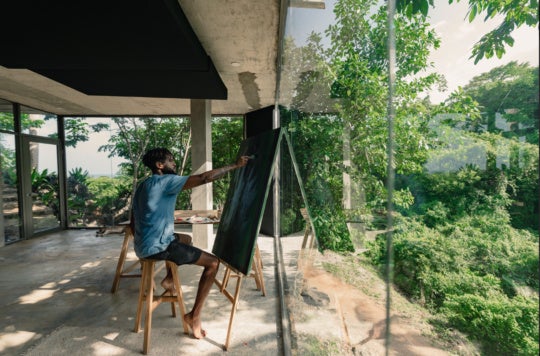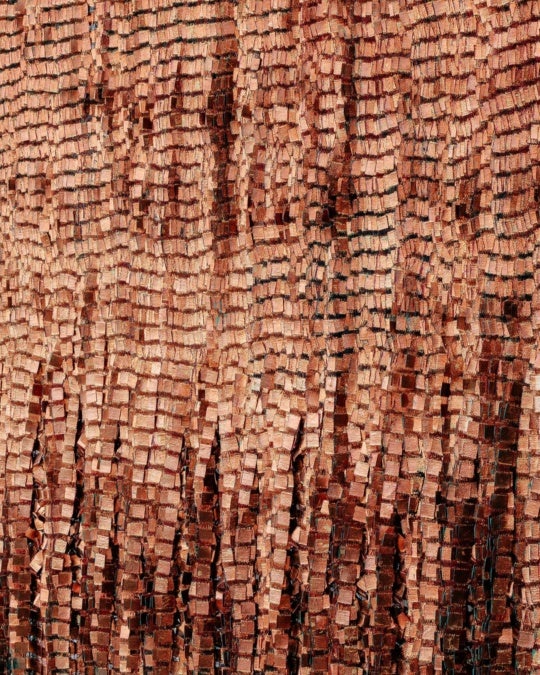![The painting "Hybrid Solar Eclipse [Rio]" by Sarah Morris, showing over brightly colored overlapping circles arranged in a grid.](https://s1.burnaway.org/wp-content/uploads/2018/05/Sarah-Morris.jpg)
British-born, New York-based artist Sarah Morris’s exhibition “Sawdust and Tinsel,” on view at the Contemporary Art Center New Orleans through June 17, presents viewers with a strong aesthetic vocabulary to think through these urgent questions—a response mediated through the visual and critical lens of 20th-century modernism. Through repetition, an appropriation of the modernist grid, and an excitable palette of flat neon colors, Morris’s paintings point to the simple grammar that encodes experiences in metropolitan centers and responds to a world emptied and filled by the logics of late capitalism.
For Morris, to engage with the contemporary city is not just to re-present the urban center and its unique material realities (skylines, a grid of streets, landmarks), but to tease out the underlying aesthetics of corporatism, industrialization, geopolitics, and commodity propaganda that render industry and culture increasingly indistinguishable.
Yet this is not to say that Morris’s paintings are mere variations on a theme, for within the precise terms and structures of her abstract works lies an infinite number of compositional choices and formal combinations. This radically generative variety is signaled to the viewer immediately upon entering the gallery in a short phrase of three “city portraits” of Rio de Janiero, Brazil, bound into space by a vivid marigold-painted wall: Bovespa [Rio] (2013); Denuza Leão [Rio] (2012); and Rio Atlantica [Rio] (2013).

Installation view of Morris’s exhibition “Sawdust and Tinsel” at the Contemporary Art Center New Orleans, including the paintings (l to r): Bovespa [Rio], 2013; Denuza Leão [Rio], (2012); and Rio Atlantica [Rio], (2013). [Photo: Alex Marks.]
For Morris, “modern” is no longer a synonym for progress and originality but describes endless change within a shallow set of terms provided by global capitalism. Like a still image of a kaleidoscope frozen in time and space, Morris’s works suggest a spectacular, virtual modernism—one that refuses the affected novelty and autonomy suggested by much of abstraction’s history and rhetoric of offering a sexy, cool, repetitive style of visual propaganda.
Slick and precise with no evidence of the artist’s hand, Morris’s paintings intentionally direct the viewer to the surface, to the repeatable patterns and formulaic terms of life under the specter of capital. These paintings tease us with their dynamic, excitable combinations yet are eager to reveal their permutational relationship to one another.

Since 1998, Morris has been making and exhibiting films alongside her painted works, many of which are deeply connected to her interest in major urban cities. They often focus on the overwhelming constellation of quotidian experience that pulses within these gargantuan communities of people, traffic, industries, and events.

The aggressive electronic soundtrack, composed by Morris’s collaborator Liam Gillick, adds an additional layer to Morris’s film and expands the terms of the artist’s engagement with the visual data and iconography of global urban capitalism by overwhelming our senses. Morris sees the city of today in a constant state of flux, as complex and mesmerizing as it is disorienting and terrifying, and her work provides a surface (whether painted or filmic) that reifies this dialectical proposal.
NOTE
1. Pulled from the following quote by Sarah Morris from Bettina Funcke’s essay “Shift to Liquid” in the exhibition catalogue Sarah Morris: Bye Bye Brazil, London: White Cube, 2013, pg. 2: “I experience and see the paintings in this same manner: visceral after-images, interfaces sometimes representing something that is repulsive, overwhelming; a system that is larger than you, with moments of inherent complicitness, and yet distance or failure built in.”
Jordan Amirkhani is an assistant professor of art history at the University of Tennessee, Chattanooga. In addition to her academic work, she serves as a regular contributor to numerous national and international arts publications including Artforum and Momus, receiving a prestigious grant from Creative Capital/Andy Warhol Foundation in 2017 for her criticism.




